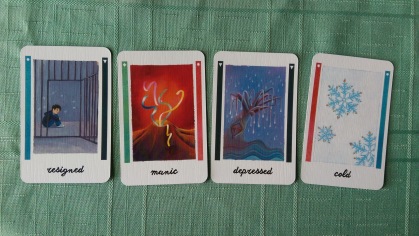…and then we held hands.
That’s the name, and goal, of this interesting little two-player co-op hand management and movement puzzle game about two people trying to save their failing relationship. In a thematic twist, players may not discuss the game itself, yet need to be aware of each other’s board state (i.e. emotional state) and work together to help each other find emotional balance as individuals before coming back together as a better couple.
I love how the communication limitation makes the game one of reading your partner’s intentions and what they hope to achieve, emulating a troubled couple who aren’t openly communicating, but both really do want to better understand each other.
Because you can’t talk about the game, it also means this is a nice opportunity to chat with your partner, just spend some time together talking and enjoying each other’s company – which is what board games are really all about, having a great time with your friends.

So, how do you play?
You’re aiming to meet in the middle, at the same time, both in emotional balance. But to even get there, you’ll first need to – as a couple – make it through the 24 objective cards, dealing with or embracing emotions like sadness and anger, while seeking calm and happiness.
Both players get a hand of emotion cards, which both can see. You discard cards to move to corresponding nodes on the board, along the black lines. Thing is, you can discard from your partner’s row, too. Here’s where communication through reading your partner comes in. If you only focus on where you’re going, and not where they need to go, you may drain them of emotions they need to deal with their stuff, and then they’ll be stuck – in which case, you both lose. So, pay attention to your partner’s needs as well as yours.

Each time you make it through a stack of objectives, you unlock a new ring – the next one closer to the centre – where you and your partner can now move. It makes things both easier and trickier – more room to move, but smaller circles, and did I mention your pieces can’t move through each other?
Nevertheless, you’ll have to move to the next level to help your relationship.
It’s also important to keep your emotions balanced. Each time you move through a negative emotion – sad or angry – you move your glass marker to the left. When you move through happy or calm, you move the marker right. But if you need to move through anger or sadness and you’re already too far negative, you can’t make that move. Same thing on the positive side. And if you can’t move at all, you’re stuck, and both lose.
Each time you find yourself in balance, you have the emotional stability to weigh your options, letting you draw cards to refresh your hand. Even when emotional objectives are right within reach, you’ll often need to retreat to seek balance before you can continue your emotional journey.

One final thematic rule: when you move across the centre line, into a different half of the board, you can change your perspective.
Your emotion cards are always splayed out to left if you’re on the left side of the board, or right if you’re on the ride side. So, crossing the line and changing perspective lets you splay the cards differently. Literally, seeing the other side of the emotions you carry with you.

Each card is a combination of two emotions, indicated on the left and right borders, so splaying your cards in a different direction gives you access to a different set of emotions.

Remember what I said before about winning this game?
Once you’ve made it through all the emotional cards you’ll need to meet in the middle, at the same time, both in emotional balance. You may have the cards you need to get into the middle, but you might have to back track to get there at the same time as your partner, or to do so with well-adjusted emotions in balance.
Playing this great little game is rewarding, relaxing, stressful, fun and tricky. You always need to be aware of your partner and their needs, and in that regard – and with many other nice rules touches mentioned above – this game succeeds with flying colours at emulating the needs of a relationship.
It’s theme is light, but very evocative, and you’ll really need to work well with your partner to get through this game together. And if you manage to succeed, what then?
…and then you hold hands.